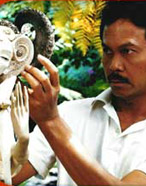 |
||
|---|---|---|
| CP Foundation | About CP Biennale | 2003 | 2005 | Contact Us | >||
           
|
||
|
In fact, we can easily categorize Widayanto's ceramic sculpture as an art work. It is clear that the sculptures reveal the artist's personal expressions. In many cases, the works also represent special matters—matters of traditions in particular. The works betray some intensely personal characters that have become Widayanto's hallmarks. The fact that Widayanto's style tends to be decorative does not necessarily mean that his works must be categorized as craft. It is worth noting that the paradigm of Indonesian craft is still vague. The quality of craftsmanship that is inherent in Widayanto's works can also be found in the works of many prominent Indonesian painters and sculptors. Widayanto's particular strength is his ability to bring back to life the traditional myths through his ceramic works. He arrives at this point after a long and tiring journey—the result of which is obvious in his mastery as he works on the cheap clay, and turns it into vivid ceramic sculptures that are highly sensual. His experience and mastery in the techniques of ceramic arts have enabled Widayanto to work and create his ceramic works free from the inhibitions often faced by most other ceramic artists in Indonesia. Asmudjo Jono Irianto Born on January 23, 1953 in Jakarta. SELECTED SOLO EXHIBITIONS |
||
|
CP Foundation | About CP Biennale | 2003 | 2005 | Contact Us
Jl. Suryopranoto 67A, Jakarta 10160, Indonesia. ph. +62.21.3448126, 3853206 | fax. +62.21.3853203, 3853208 info@cp-foundation.org |
||
 While the public mostly finds the works of other ceramic artists still difficult to appreciate and understand, Widayanto has succeeded in popularizing the art of ceramics, in this case ceramics as an expressive medium. It can also be said that Widayanto is quite a controversial figure in the Indonesian art world —this is true whether we are talking about the visual arts in general, or about the ceramic arts in particular. This has to do with Widayanto's creative attitude and tendency. He seems to be unconcerned about the differences between art works and non-art works, and this attitude often makes the art community treat him with suspicions. Such suspicions are further strengthened by the fact that he has also been managing a ceramic studio that creates functional products.His controversial statements notwithstanding, it is obvious that Widayanto is very serious in creating his ceramic as an art work. He has often exhibited his works in various solo exhibitions; most of the works are in the form of ceramic sculptures. The intense decorative nuances of his works have been one of the causes why the art community often doubts whether Widayanto's works are the art work. Many parties consider his works as craft works. Widayanto's ceramic sculptures can indeed become a means to question the art categorization in Indonesia—in this case especially about the dichotomy between art and craft, a belief that we have adopted from the West.
While the public mostly finds the works of other ceramic artists still difficult to appreciate and understand, Widayanto has succeeded in popularizing the art of ceramics, in this case ceramics as an expressive medium. It can also be said that Widayanto is quite a controversial figure in the Indonesian art world —this is true whether we are talking about the visual arts in general, or about the ceramic arts in particular. This has to do with Widayanto's creative attitude and tendency. He seems to be unconcerned about the differences between art works and non-art works, and this attitude often makes the art community treat him with suspicions. Such suspicions are further strengthened by the fact that he has also been managing a ceramic studio that creates functional products.His controversial statements notwithstanding, it is obvious that Widayanto is very serious in creating his ceramic as an art work. He has often exhibited his works in various solo exhibitions; most of the works are in the form of ceramic sculptures. The intense decorative nuances of his works have been one of the causes why the art community often doubts whether Widayanto's works are the art work. Many parties consider his works as craft works. Widayanto's ceramic sculptures can indeed become a means to question the art categorization in Indonesia—in this case especially about the dichotomy between art and craft, a belief that we have adopted from the West.